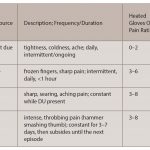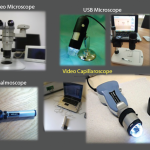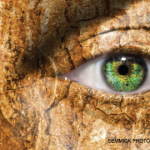This study provides a unique physical therapist–patient perspective on unreported characteristics of dSSc and management of functional limitations imposed by the disease. Barb, eight years post progressive dSSc diagnosis, had had recurrent DUs yet experienced decreased pain and no DUs during the four-month intervention of daily, continuous use of heated gloves. The incapacitating pain associated with active acro-osteolysis was greatly reduced while the heated gloves were on. However, consistent with Park et al, Barb’s acro-osteolysis did not stop despite increased circulation to the digits.5 As a result, Barb’s fingers continued to shorten and impair hand function.
Interestingly, ROM improved in the right wrist, bilateral 2nd digits and left 5th digit. This increase occurred despite no formal stretching or strengthening exercises during the four-month intervention period. Additionally, two surprising outcomes of this study were the improvements in the nine-hole peg test performance and the return of sensation in six digits, especially the left digits. The left 5th digit improved from loss of protective sensation to within normal range. The 2nd digit had a four-year history of ulcers, yet sensation improved in the intervention period from loss of protective sensation to reduced protective sensation (see Table 3).
Conclusion
The promising outcomes in this case warrant further patient-centered research to establish efficacy and optimum parameters for heated glove use. More research is needed to assess the prophylactic potential of prescribing daily, continuous heat earlier in the disease process to perhaps delay the sequelae of dSSc vasculopathy.
Barb controlled for variables through consistent data collection methods, including setting, time frame (11 a.m.), rater and instrumentation. Subject characteristics were controlled; there were no changes in occupation, activities, diet, medication or stress levels. Therefore, future research based on Barb’s design may be feasible to determine benefit and generalizability to the larger scleroderma population.
Read “A Glove By Any Other Name May Give Less Heat,” (The Rheumatologist, November 2017).
 Rosemarie Curley, MPT, DPT, completed her transitional doctorate from Northeastern University College of Professional Studies in July and practices physical therapy in inpatient rehabilitation in Richmond, Va. Personal experience with topical steroid withdrawal in children and diffuse systemic sclerosis fuels her desire to research and present the patient’s perspective in evidence-based practice.
Rosemarie Curley, MPT, DPT, completed her transitional doctorate from Northeastern University College of Professional Studies in July and practices physical therapy in inpatient rehabilitation in Richmond, Va. Personal experience with topical steroid withdrawal in children and diffuse systemic sclerosis fuels her desire to research and present the patient’s perspective in evidence-based practice.
 Jeananne Elkins, PT, PhD, DPT, MPH, is an advanced fellow in geriatrics at the Birmingham/Atlanta VA Geriatrics Research Education and Clinical Care Center (GRECC) in Atlanta. She is a health services researcher. Her recent work is in evidence-based physical therapy interventions and in medical care–caregiver interactions to improve support of informal caregivers.
Jeananne Elkins, PT, PhD, DPT, MPH, is an advanced fellow in geriatrics at the Birmingham/Atlanta VA Geriatrics Research Education and Clinical Care Center (GRECC) in Atlanta. She is a health services researcher. Her recent work is in evidence-based physical therapy interventions and in medical care–caregiver interactions to improve support of informal caregivers.
Disclosure
The authors have no financial/benefit ties with the gloves described in this article.
References
- Matucci-Cerinic M, Kahaleh B, Wigley FM. Review: Evidence that systemic sclerosis is a vascular disease. Arthritis Rheum. 2013 Aug;65(8):1953–1962.
- Varga J. Abraham D. Systemic sclerosis: A prototypic multisystem fibrotic disorder. J Clin Invest. 2007 Mar;117(3):557–567.
- Wigley FM Flavahan NA. Raynaud’s phenomenon. N Engl J Med. 2016 Aug 11;375(6):556–565.
- Merkel PA, Herlyn K, Martin RW, et al. Measuring disease activity and functional status in patients with scleroderma and Raynaud’s phenomenon. Arthritis Rheum. 2002 Sep;46(9):2410–2420.
- Park JK, Fava A, Carrino J, et al. Association of acroosteolysis with enhanced osteoclastogenesis and higher blood levels of vascular endothelial growth factor in systemic sclerosis. Arthritis Rheumatol. 2016 Jan;68(1):201–209.
- Robinson DJ, Eisenberg D, Nietert PJ, et al. Systemic sclerosis prevalence and comorbidities in the US, 2001–2002. Curr Med Res Opin. 2008 Apr;24(4):1157–1166.
- Shah AA, Wigley FM. My approach to the treatment of scleroderma. Mayo Clin Proc. 2013 Apr;88(4):377–393.
- Barnes J, Mayes MD. Epidemiology of systemic sclerosis: Incidence, prevalence, survival, risk factors, malignancy, and environmental triggers. Curr Opin Rheumatol. 2012 Mar;24(2):165–170.
- Steen VD, Medsger TA. Changes in causes of death in systemic sclerosis, 1972-2002.
Ann Rheum Dis. 2007 Jul;66(7):940–944 - Amanzi L, Braschi F, Fiori G, et al. Digital ulcers in scleroderma: Staging, characteristics and sub-setting through observation of 1614 digital lesions. Rheumatology (Oxford). 2010 Jul;49(7):1374–1382.
- Cappelli L, Wigley FM. Management of Raynaud phenomenon and digital ulcers in scleroderma. Rheum Dis Clin North Am. 2015 Aug;41(3):419–438.
- Thombs BD, Jewett LR, Assassi S, et al. New directions for patient-centred care in scleroderma: The Scleroderma Patient-Centred Intervention Network (SPIN). Clin Exp Rheumatol. 2012 Mar–Apr;30(2 Suppl 71):S23–S29.
- Danieli E, Airo P, Bettoni L, et al. Health-related quality of life measured by the Short Form 36 (SF-36) in systemic sclerosis: Correlations with indexes of disease activity and severity, disability, and depressive symptoms. Clin Rheumatol. 2005 Feb;24(1):48–54.
- Schiopu E, Impens AJ, Phillips K. Digital ischemia in scleroderma spectrum of diseases. Int J Rheumatol. 2010;2010. pii: 923743.
- Hughes M, Herrick AL. Digital ulcers in systemic sclerosis. Rheumatology (Oxford). 2017 Jan;56(1):14–25.
- Moran ME. Scleroderma and evidence based non-pharmaceutical treatment modalities for digital ulcers: A systematic review. J Wound Care. 2014 Oct;23(10):510–514.
- Brand M, Hollaender R, Rosenberg D, et al. An observational cohort study of patients with newly diagnosed digital ulcer disease secondary to systemic sclerosis registered in the EUSTAR database. Clin Exp Rheumatol. 2015 Jul–Aug;33(4 Suppl 91):S47–S54.
- Mouthon L, Carpentier PH, Lok C, et al. Ischemic digital ulcers affect hand disability and pain in systemic sclerosis. J Rheumatol. 2014 Jul;41(7):1317–1323.
- Magee DJ. Orthopedic Physical Assessment, 5th ed. St. Louis: Saunders Elsevier, 2008.
- Young A, Namas R, Dodge C, Khanna D. Hand impairment in systemic sclerosis: Various manifestations and currently available treatment. Curr Treatm Opt Rheumatol. 2016;2(3):252–269.
- Tresolini C, the Pew-Fetzer Task Force. Health Professions Education and Relationship-Centered Care. San Francisco: 1994.
- Hudson M, Thombs BD, Steele R, et al. Health-related quality of life in systemic sclerosis: A systematic review. Arthritis Rheum. 2009 Aug 15;61(8):1112–1120.
- Askew LJ, Beckett VL, An KN, Chao EY. Objective evaluation of hand function in scleroderma patients to assess effectiveness of physical therapy. Br J Rheumatol. 1983 Nov;22(4):224–232.
- Mancuso T, Poole JL. The effect of paraffin and exercise on hand function in persons with scleroderma: A series of single case studies. J Hand Ther. 2009 Jan–Mar;22(1):71–77, quiz 78.
- Nasir SH, Troynikov O, Massy-Westropp N. Therapy gloves for patients with rheumatoid arthritis: A review. Ther Adv Musculoskelet Dis. 2014 Dec;6(6):226–237.
- Stefanantoni K, Sciarra I, Iannace N, et al. Occupational therapy integrated with a self-administered stretching program on systemic sclerosis patients with hand involvement. Clin Exp Rheumatol. 2016 Sep–Oct;34 Suppl 100(5):157–161.
- Vannajak K, Boonprakob Y, Eungpinichpong W, et al. The short-term effect of gloving in combination with traditional Thai massage, heat, and stretching exercise to improve hand mobility in scleroderma patients. J Ayurveda Integr Med. 2014 Jan;5(1):50–55.
- Frank L, Basch E, Selby JV, et al. The PCORI perspective on patient-centered outcomes research. JAMA. 2014 Oct 15;312(15):1513–1514.
- Jensen MP, McFarland CA. Increasing the reliability and validity of pain intensity measurment in chronic pain patients. Pain. 1993 Nov;55(2):195–203.
- Leung YY, Ho KW, Zhu TY, et al. Construct validity of the modified numeric rating scale of patient global assessment in psoriatic arthritis. J Rheumatol. 2012 Apr;39(4):844–848.
- Rehab measures: Numeric pain rating scale. 1995; reviewed 2013 Jan 17.
- Bijur PE, Latimer CT, Gallagher EJ. Validation of verbally administered numerical rating scale of acute pain use in the emergency department. Acad Emerg Med. 2003 Apr;10(4):390–392.
- Farrar JT, Young JP Jr, LaMoreaux L. Clinical importance of changes in chronic pain intensity measured on an 11-point numerical pain scale. Pain. 2001 Nov;94(2):149–158.
- Mathiowetz V, Kashman N, Volland G, et al. Grip and pinch strength: Normative data for adults. Arch Phys Med Rehabil. 1985 Feb;66(2):69–74.
- Mathiowetz V. Comparison of Roylan and Jamar dynamometers for measuring grip strength. Occup Ther Int. 2002;9(3):201–209.
- Norkin CC, White DJ. Measurement of Joint Motion: A Guide to Goniometry, 5th ed. Philadelphia: FA Davis Company; 1985.
- Lewis E, Fors L, Tharion WJ. Interrater and intrarater reliability of finger goniometric measurements. Am J Occup Ther. 2010 Jul–Aug;64(4):555–561.
- Uddin Z, MacDermid JC, Ham HH. Test–retest reliability and validity of normative cut-offs of the two devices measuring touch threshold: West Enhanced Sensory Test and Pressure-Specified Sensory Device. Hand Therapy. 2014;9(14).
- Mathiowetz V, Weber K, Kashman N, Volland G. Adult norms for the nine-hole peg test of finger dexterity. OTJR (Thorofare N J). 1985;5(1):24–38.
- Wang YC, Magasi SR, Bohannon RW, et al. Assessing dexterity function: a comparison of two alternatives for the NIH Toolbox. J Hand Ther. 2011 Oct–Dec;24(4):313–320.
- Sandqvist G, Eklund M. Hand Mobility in Scleroderma (HAMIS) test: The reliability of a novel hand function test. Arthritis Care Res. 2000 Dec;13(6):369–374.
- Sandqvist G, Eklund M. Validity of HAMIS: A test of hand mobility in scleroderma. Arthritis Care Res. 2000 Dec;13(6):382–387.
- Lefevre-Colau MM, Poiraudeau S, Oberlin C, et al. Reliability, validity, and responsiveness of the modified Kapandji index for assessment of functional mobility of the rheumatoid hand. Arch Phys Med Rehabil. 2003 Jul;84(7):1032–1038.


